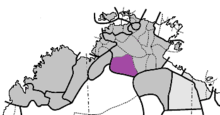Wardaman language
Wardaman is an Australian Aboriginal language isolate. It is one of the northern non-Pama–Nyungan languages. Dagoman and Yangman (both extinct) were either dialects or closely related languages; as a family, these are called Yangmanic.
| Wardaman | |
|---|---|
| Yangmanic | |
| Native to | Australia |
| Region | Northern Territory |
| Ethnicity | Wardaman, Dagoman, Yangman |
Native speakers | 50 (2016 census)[1] |
Yangmanic or language isolate[2] | |
| Dialects |
|
| Language codes | |
| ISO 639-3 | Variously:wrr – Wardamandgn – Dagomanjng – Yangman |
| Glottolog | yang1287[4] |
| AIATSIS[5] | N35 Wardaman, N38 Dagoman, N68 Yangman |
 Yangmanic languages (purple), among other non-Pama-Nyungan languages (grey) | |
Classification
Though previously classified as Gunwinyguan, the Yangmanic languages have not been demonstrated to be related to other languages.[2]
The isolate Wagiman shares a very similar morphosyntactic profile with the Yangmanic languages, although they share very low cognacy rates (about 10% according to Stephen Wilson[6]). Francesca Merlan supports its grouping together with Yangmanic[7], citing that both together differ from neighbouring languages (such as the Gunwinyguan language Jawoyn and Mangarrayi) while sharing very similar syntax with each other, such as their similar use of 'verbal particles'.
Sounds
The inventory of Wardaman proper:
Consonants
| Peripheral | Alveolo- palatal |
Apical | |||
|---|---|---|---|---|---|
| Bilabial | Velar | Alveolar | Retroflex | ||
| Stop | b | ɡ | d̠ʲ | d | ɖ |
| Nasal | m | ŋ | n̠ʲ | n | ɳ |
| Lateral | l̠ʲ | l | ɭ | ||
| Flap | ɾ | ||||
| Approximant | β̞ | j | ɹ̠ | ||
The alveolo-palatals are pronounced with the blade of the tongue; at the end of a syllable they may sound like yn and yl to an English ear. Even the y is said to have lateral spread and to be pronounced with the blade and body of the tongue. There is very little acoustic difference between the two apical series compared to other languages in the area. The alveolars may add a slight retroflex onglide to a following vowel, and the retroflexes may assimilate alveolars in the same word. Nonetheless, they remain phonemically distinct. Francesca describes the w as bilabial, and notes that there is little or no lip rounding or protrusion (except in assimilation to a following /u/ or /o/). The r is post-alveolar.
Notes
- "Census 2016, Language spoken at home by Sex (SA2+)". stat.data.abs.gov.au. ABS. Retrieved 30 October 2017.
- Bowern, Claire. How Many Languages Were Spoken in Australia? 2011.
- Dixon, R. M. W. (2002). Australian Languages: Their Nature and Development. Cambridge University Press. p. xl.
- Hammarström, Harald; Forkel, Robert; Haspelmath, Martin, eds. (2017). "Yangmanic". Glottolog 3.0. Jena, Germany: Max Planck Institute for the Science of Human History.
- N35 Wardaman at the Australian Indigenous Languages Database, Australian Institute of Aboriginal and Torres Strait Islander Studies (see the info box for additional links)
- Wilson, Stephen; Center for the Study of Language and Information (U.S.) (1999), Coverbs and complex predicates in Wagiman, CSLI ; Cambridge : Cambridge University Press, pp. 5–6, ISBN 978-1-57586-172-2
- Merlan, Francesca (1994), A grammar of Wardaman : a language of the Northern Territory of Australia, Mouton de Gruyter, pp. 3–4, ISBN 978-3-11-012942-7
References
- Merlan Francesca. 1983. A Grammar of Wardaman. A Language of the Northern Territory of Australia. Mouton de Gruyter. 1994.